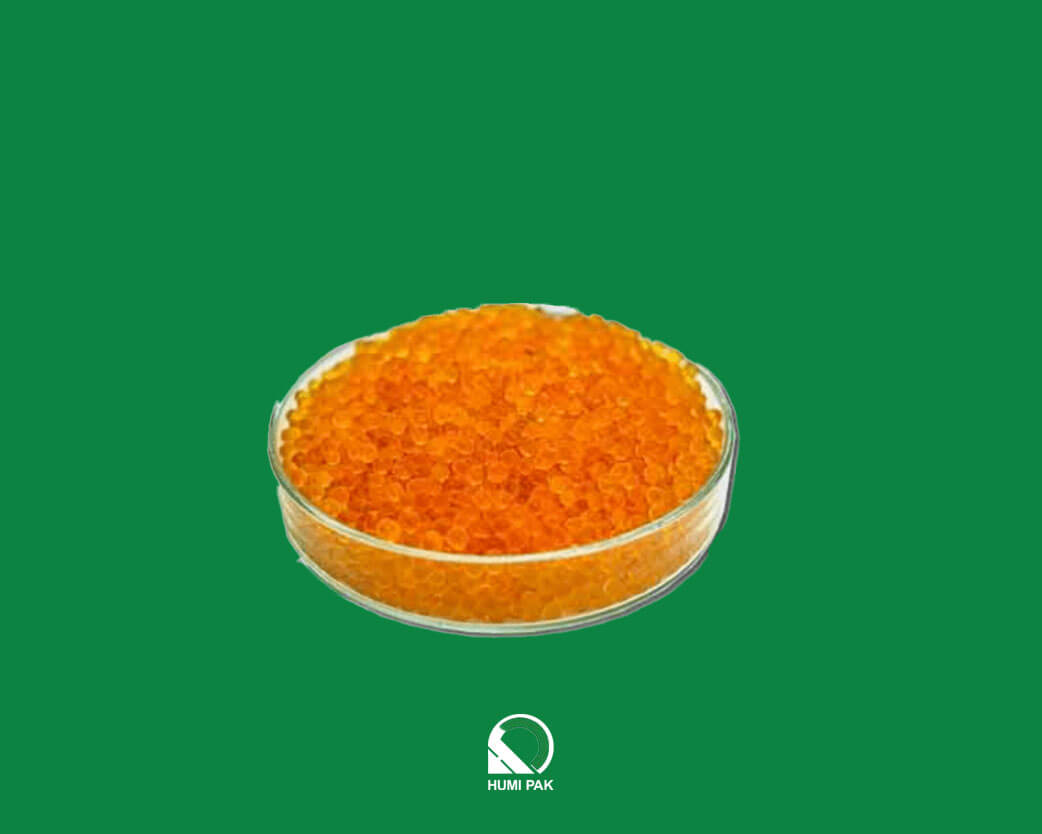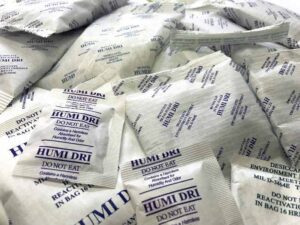Uses of Silica Gel Desiccants

Moisture control is vital for many products, especially regarding storage and transportation. One of the most commonly used tools is the humble silica gel, a substance often encountered in small packets inside various product packages. This article will share more about silica gel and why its role as a desiccant is so widespread and important.
What is Silica Gel?
 Desiccants are materials designed to pull and retain moisture from their surroundings. Their operation can be through either adsorption or absorption. In the case of silica gel, it works through adsorption, meaning water molecules stick to the gel’s surface without a chemical reaction.
Desiccants are materials designed to pull and retain moisture from their surroundings. Their operation can be through either adsorption or absorption. In the case of silica gel, it works through adsorption, meaning water molecules stick to the gel’s surface without a chemical reaction.
This capability to control humidity is crucial in many scenarios, such as storing electronics or food, where even minor moisture can compromise product quality or lifespan. Through maintaining consistently low humidity levels, desiccants like silica gel play a key role in product protection.
Silica gels comprise amorphous forms of silicon dioxide with atoms of an irregular framework and are usually packed in a small sachet. Each desiccant bead has a large surface area of around 800m2/g due to its many tiny, interconnected pores.
The desiccant is a tridimensional oxygen and silicon atoms structure with nanometer void spaces. Even when saturated with moisture, these tiny pores hold onto the water molecules by capillary condensation, making the beads appear dry. Silica gels also commonly function as a moisture indicator, stabilising and maintaining the relative humidity in the surrounding environment or enclosed space by absorbing and desorbing moisture. Effectively absorbing moisture and humidity reduces the likelihood of mould growth and can prevent food spoilage.
Properties of Desiccants
Silica gel is often recognisable by its appearance as small, clear, or slightly milky beads. In certain versions, moisture indicators change colour upon reaching saturation, offering a visual cue about its moisture-absorbing state.
When touched, these beads feel solid, emphasising their non-liquid nature. Beyond its physical form, silica gel is also non-toxic, odourless, and chemically inert. This wide range of safe properties makes it adaptable to many applications. One of the most commendable features of silica gel is its porous internal structure.
This intricate network of pores provides the gel with an extensive surface area, a key contributor to its remarkable adsorption capabilities. Moreover, its density, which can be quite lightweight, is influenced by its moisture content. As the beads become drier, they tend to be lighter.
Absorption Mechanism: The primary method of silica gel capturing moisture is adsorption. During this process, water molecules adhere to the surfaces of the gel beads without undergoing any chemical transformation. Enhancing this moisture-attracting capability is the gel’s polar surface.
Embedded with polar hydroxyl (OH) groups, silica gel possesses a heightened affinity for water, drawing in moisture even from relatively dry environments. Its effectiveness is not limited to a narrow humidity range. Silica gel showcases its moisture-retaining prowess across a wide spectrum of relative humidity levels, capable of holding a substantial portion of its weight in water as environmental humidity rises.
Reusability: When it becomes saturated with moisture, it needn’t be discarded. Instead, the trapped water can be expelled by applying heat, restoring the gel’s drying potential. This unique characteristic enables silica gel to undergo multiple usage cycles, enhancing its value in industrial settings. In terms of durability, with adequate care and periodic reactivation, silica gel can retain its effectiveness over an extended period spanning several years.
It boasts resistance against most chemical impacts and degradation. However, it’s essential to note that while it’s reusable, silica gel’s efficiency may gradually decline after numerous regeneration cycles. As such, especially in sensitive or critical applications, keeping a close eye on its performance is imperative, ensuring it maintains its optimum moisture-absorbing capability.
Common Uses of Silica Gel Desiccants
Due to their unparalleled moisture-absorbing properties, Silica gel desiccants have become integral to various sectors. Here are some common applications:
Packaging and Storage Solutions
The value of a product often depends on its quality upon arrival, and silica gel ensures products remain in peak condition by preventing moisture-related damages.
Electronics Packaging: Devices like smartphones, cameras, and computer components are sensitive to humidity. Even minor moisture exposure can lead to circuit damage or system failure. Silica gel packets placed within electronics packaging help maintain a dry environment, protecting these devices during transit and storage.
Pharmaceutical Packaging: Medications, whether in pill, capsule, or powder form, must be stored in a moisture-free environment to ensure their efficacy. Silica gel canisters or packets control humidity in pharmaceutical containers, preventing pill agglomeration and preserving drug potency.
Food Storage: Certain foods, particularly those that are freeze-dried or dehydrated, require low-humidity storage conditions. Silica gel sachets in product packaging prolong shelf life by preventing mould growth and preserving flavour and texture.
Personal Items Protection
Everyday items can benefit from silica gel’s moisture-controlling properties.
Shoe Boxes: Manufacturers often place silica gel packets inside shoe boxes to keep shoes fresh and free from mould or mildew. This is especially crucial for leather or suede shoes, which are more susceptible to moisture damage.
Handbags and Luggage: Silica gel can protect bags from unpleasant odours and potential mould growth. When storing bags or using them in humid regions, silica gel packets can be placed inside to maintain a dry interior.
Jewellery and Metal Preservation: Humidity can tarnish silver and other metals. Storing jewellery with small silica gel sachets can prevent oxidation, ensuring jewellery remains untarnished and lustrous.
Museums and Archives
Preserving the past requires meticulous care, and silica gel aids this endeavour.
Document Preservation: Valuable manuscripts, photographs, and historical documents are sensitive to moisture, leading to ink smudging, mould growth, and paper deterioration. Silica gel in archival storage creates a controlled environment, ensuring the longevity of these irreplaceable items.
Artefact Conservation: Museums house artefacts made of various materials, from metal and wood to textiles. By using silica gel in display cases and storage areas, museums can regulate humidity levels, preventing corrosion, decay, and degradation.
DIY and Household Uses
Even beyond commercial applications, silica gel finds utility in home-based projects and solutions.
Window Condensation Reduction: Window condensation can persist during colder months. Placing silica gel on windowsills can help absorb excess moisture, reducing fogging and potential mould growth.
Flower Drying: For those who enjoy preserving the beauty of flowers, silica gel is a favourite choice. By burying flowers in a container filled with silica gel, they can be dried while retaining their shape and colour, creating lasting floral arrangements.
Specialty and Niche Applications
Due to their effective moisture-absorbing properties, Silica gel desiccants are utilised in various specialised sectors. Here are some of the more niche applications where they play a pivotal role:
Industrial Processes
Maintaining an optimal environment within large-scale operations and intricate procedures is crucial, and silica gel desiccants are pivotal in achieving this balance.
Gas Purification: In industries that involve producing and using gases, these gases must remain pure and devoid of impurities. Silica gel is a drying agent in gas purification systems, effectively removing moisture from natural gas, air, and hydrogen. Doing so prevents corrosion in pipelines and maintains the integrity of the gas.
Chromatography: Chromatography is a laboratory technique that separates and analyses complex mixtures. The stationary phase, often composed of silica gel, is vital for the separation process. Its porous structure allows for varying interactions with different components, enabling their sequential release and analysis.
Aviation and Marine Use
The extreme conditions experienced in aviation and marine environments necessitate specialised preservation techniques. Silica gel desiccants rise to this challenge, ensuring the protection of crucial equipment.
Aircraft Equipment Preservation: Aircraft, when not in use, are vulnerable to moisture, which can damage avionic systems, corrode metal parts, and compromise the integrity of rubber seals. By placing desiccant bags or canisters within aircraft storage areas, moisture is effectively controlled, safeguarding the aircraft and prolonging the life of its components.
Marine Vessel Storage: Ships and boats face constant exposure to high humidity and saline conditions. When marine vessels are docked or in storage, silica gel helps mitigate the risks of mould, mildew, and corrosion. Given the value and sensitivity of marine equipment, ensuring a dry internal environment is paramount for its longevity.
Conclusion
Silica gel desiccants play a pivotal role in modern packaging solutions. Their consistent and reliable moisture-absorbing properties make them an essential tool in various industries. The applications are vast and varied, from protecting electronics against humidity damage to ensuring that pharmaceuticals maintain their efficacy.
Beyond everyday items, silica gel is also crucial in specialised sectors, highlighting its adaptability and effectiveness. Humi Pak, an ISO 9001 and 14001 certified manufacturer, produces quality silica gel desiccant packs in Malaysia. Our QA laboratory conducts rigorous daily inspections. Feel free to contact us for more information.

